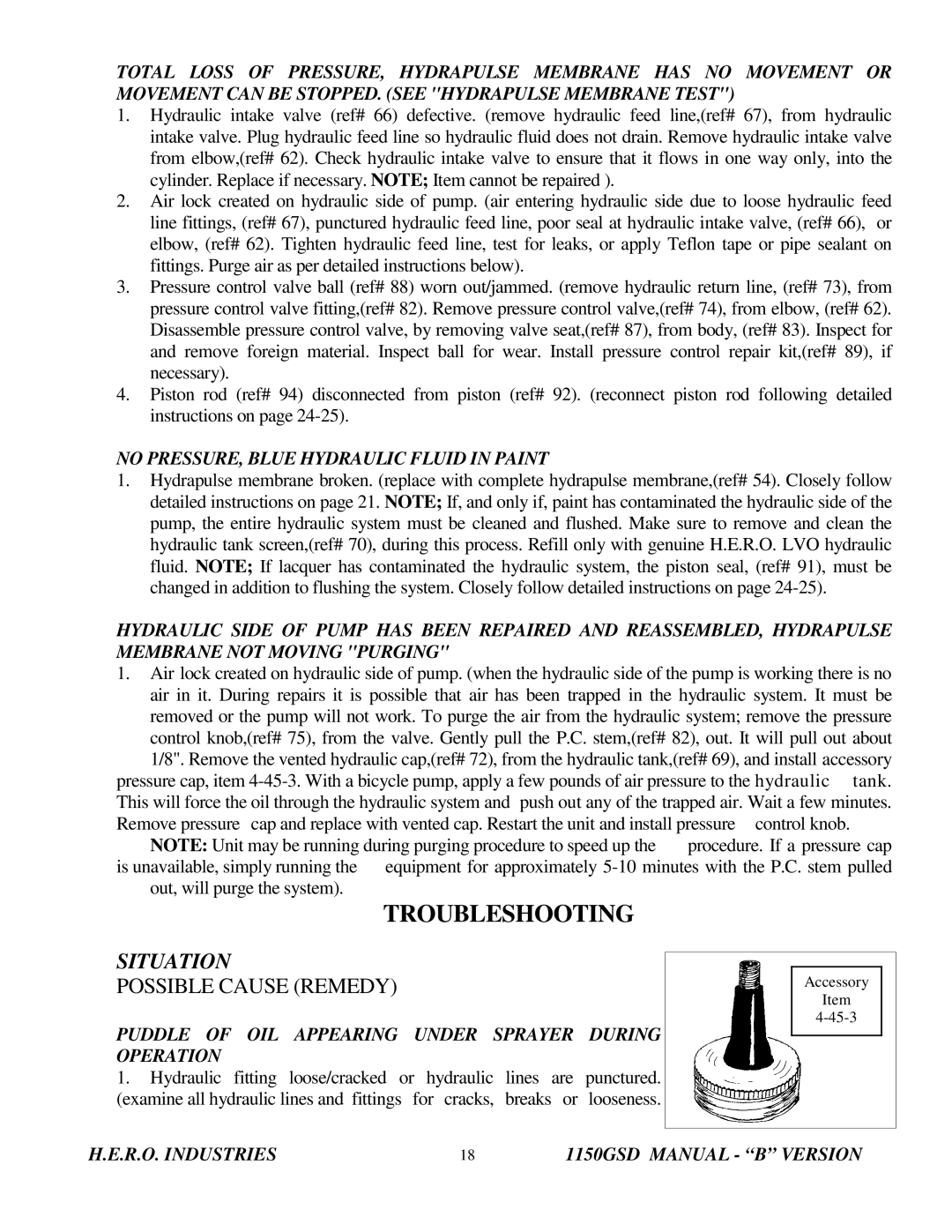
TOTAL LOSS OF PRESSURE, HYDRAPULSE MEMBRANE HAS NO MOVEMENT OR MOVEMENT CAN BE STOPPED. (SEE "HYDRAPULSE MEMBRANE TEST")
1.Hydraulic intake valve (ref# 66) defective. (remove hydraulic feed line,(ref# 67), from hydraulic intake valve. Plug hydraulic feed line so hydraulic fluid does not drain. Remove hydraulic intake valve from elbow,(ref# 62). Check hydraulic intake valve to ensure that it flows in one way only, into the cylinder. Replace if necessary. NOTE; Item cannot be repaired ).
2.Air lock created on hydraulic side of pump. (air entering hydraulic side due to loose hydraulic feed line fittings, (ref# 67), punctured hydraulic feed line, poor seal at hydraulic intake valve, (ref# 66), or elbow, (ref# 62). Tighten hydraulic feed line, test for leaks, or apply Teflon tape or pipe sealant on fittings. Purge air as per detailed instructions below).
3.Pressure control valve ball (ref# 88) worn out/jammed. (remove hydraulic return line, (ref# 73), from pressure control valve fitting,(ref# 82). Remove pressure control valve,(ref# 74), from elbow, (ref# 62). Disassemble pressure control valve, by removing valve seat,(ref# 87), from body, (ref# 83). Inspect for and remove foreign material. Inspect ball for wear. Install pressure control repair kit,(ref# 89), if necessary).
4.Piston rod (ref# 94) disconnected from piston (ref# 92). (reconnect piston rod following detailed instructions on page
NO PRESSURE, BLUE HYDRAULIC FLUID IN PAINT
1.Hydrapulse membrane broken. (replace with complete hydrapulse membrane,(ref# 54). Closely follow detailed instructions on page 21. NOTE; If, and only if, paint has contaminated the hydraulic side of the pump, the entire hydraulic system must be cleaned and flushed. Make sure to remove and clean the hydraulic tank screen,(ref# 70), during this process. Refill only with genuine H.E.R.O. LVO hydraulic fluid. NOTE; If lacquer has contaminated the hydraulic system, the piston seal, (ref# 91), must be changed in addition to flushing the system. Closely follow detailed instructions on page
HYDRAULIC SIDE OF PUMP HAS BEEN REPAIRED AND REASSEMBLED, HYDRAPULSE MEMBRANE NOT MOVING "PURGING"
1.Air lock created on hydraulic side of pump. (when the hydraulic side of the pump is working there is no air in it. During repairs it is possible that air has been trapped in the hydraulic system. It must be removed or the pump will not work. To purge the air from the hydraulic system; remove the pressure control knob,(ref# 75), from the valve. Gently pull the P.C. stem,(ref# 82), out. It will pull out about
1/8". Remove the vented hydraulic cap,(ref# 72), from the hydraulic tank,(ref# 69), and install accessory pressure cap, item
NOTE: Unit may be running during purging procedure to speed up the | procedure. If a pressure cap | |
is unavailable, simply running the | equipment for approximately | |
out, will purge the system). |
|
|
TROUBLESHOOTING
SITUATION
POSSIBLE CAUSE (REMEDY)
PUDDLE OF OIL APPEARING UNDER SPRAYER DURING OPERATION
1.Hydraulic fitting loose/cracked or hydraulic lines are punctured. (examine all hydraulic lines and fittings for cracks, breaks or looseness.
Accessory
Item
H.E.R.O. INDUSTRIES | 18 | 1150GSD MANUAL - “B” VERSION |
